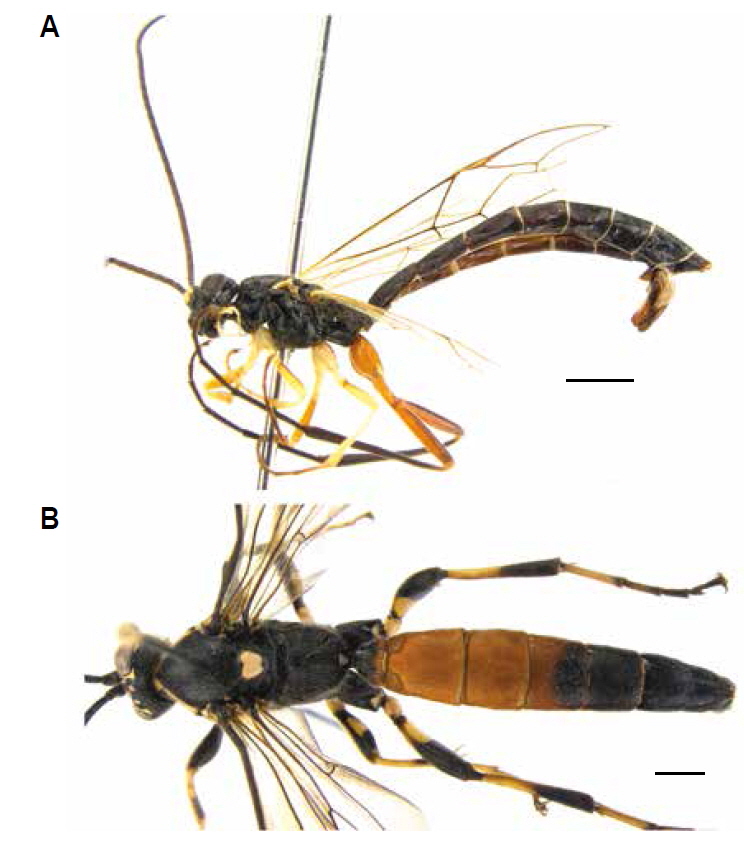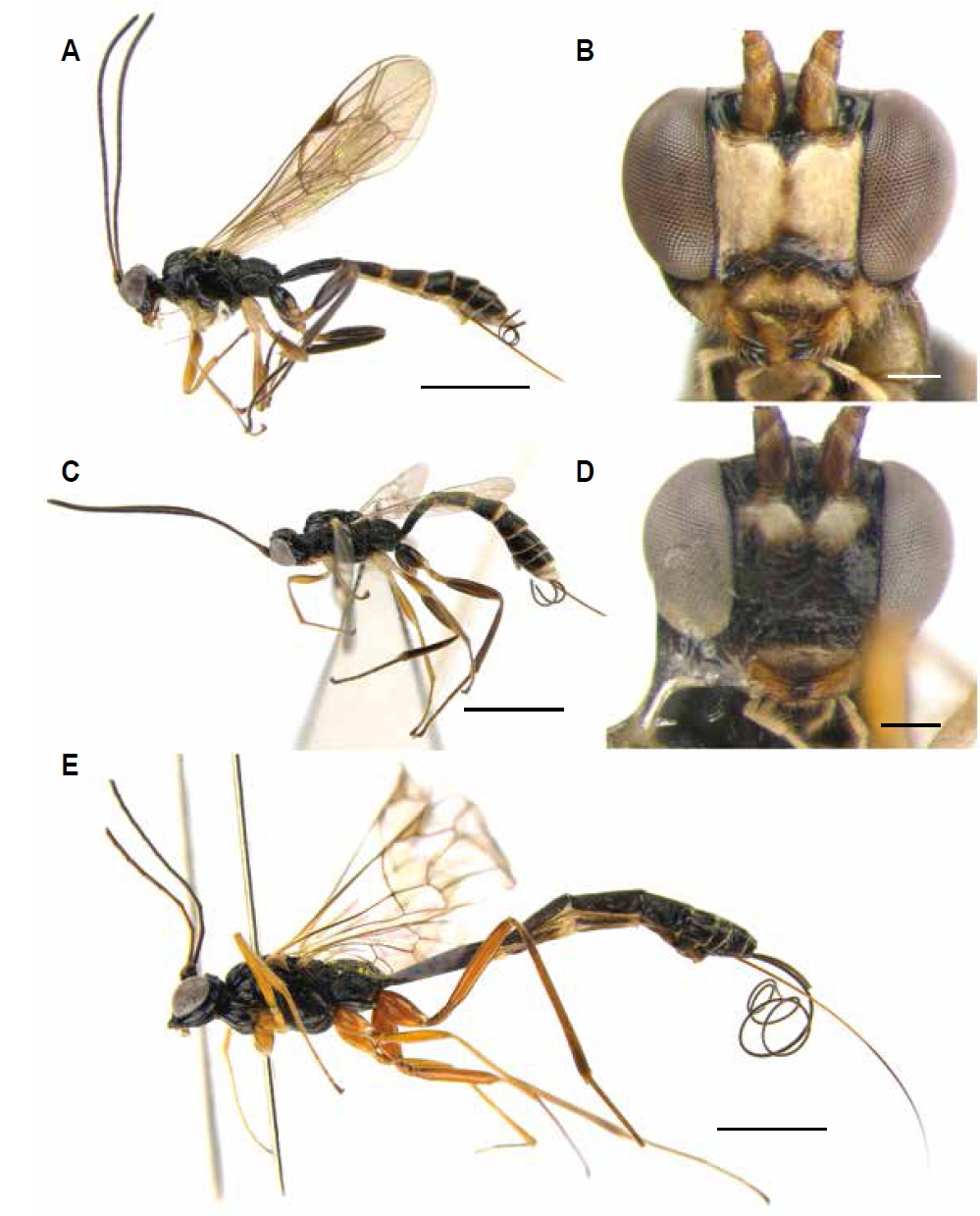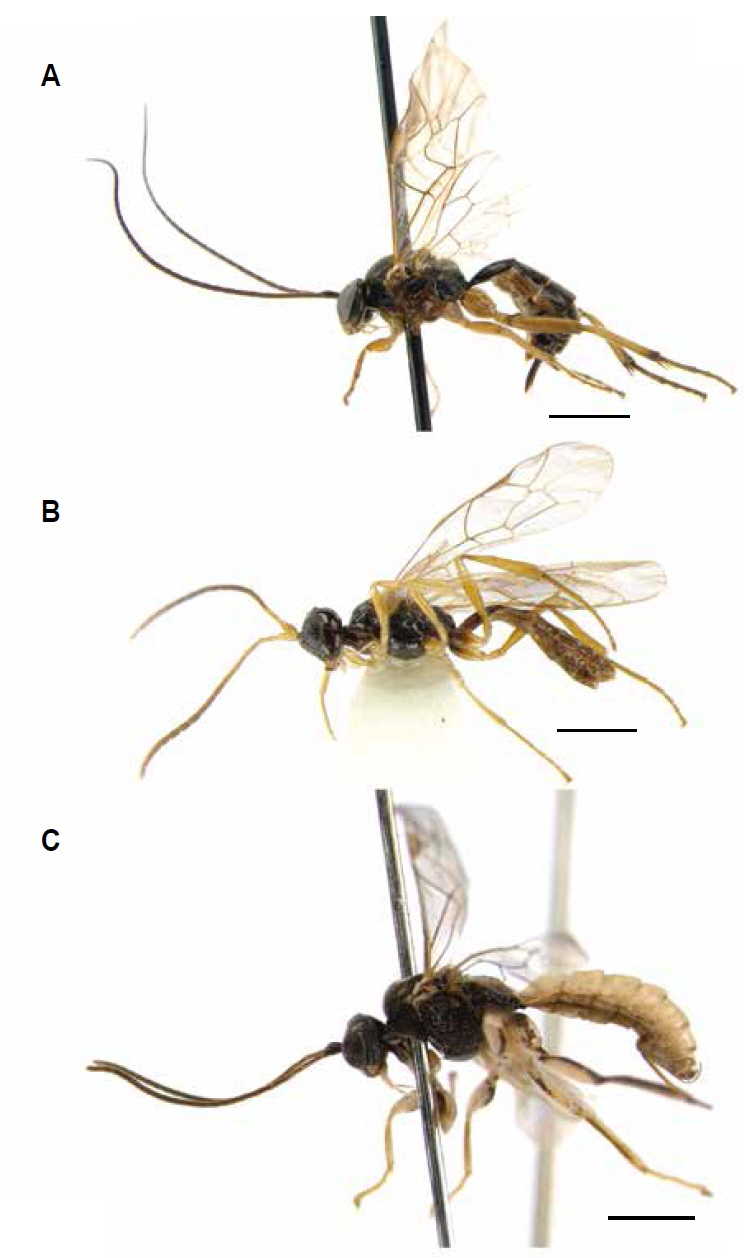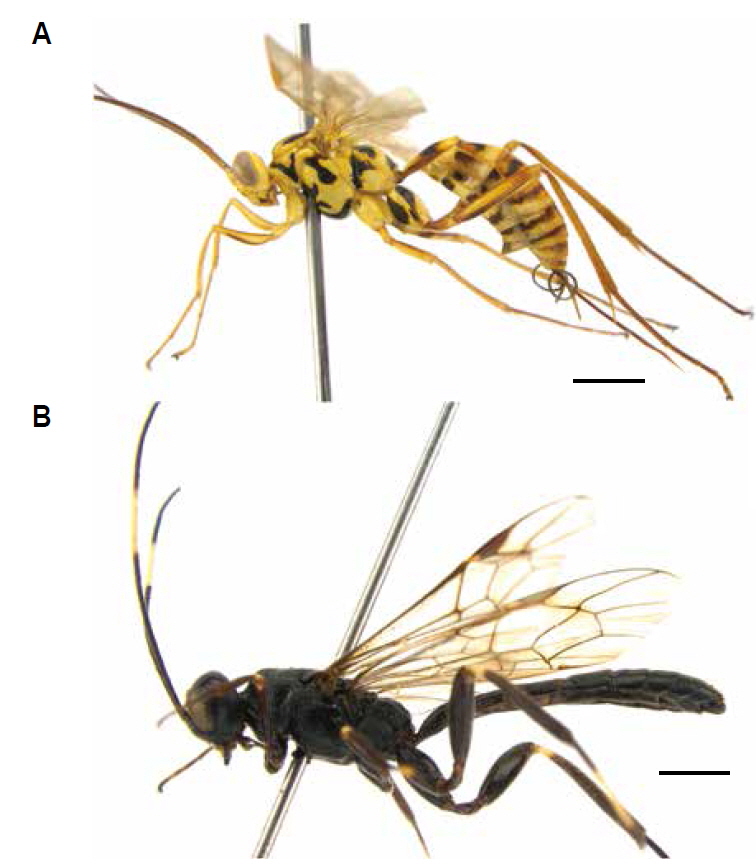



We report ten ichneumonids species new to South Korea. These species belong to eight subfamilies, Acaenitinae
The family Ichneumonidae Latreille, 1802 is a small to large-sized family containing 24,281 described species within 1,579 genera worldwide. Of these, 540 species have been recorded from South Korea (Yu et al., 2012). Most ichneumonids are endo-ectoparasitoids of Lepidoptera, Coleoptera, Hymenoptera, Diptera or Arachnida. Therefore, ichneumon flies are important to control of reproduction of injurious insects (Bartlett et al., 1978). Known species number and biological information of ichneumonid subfamilies and genera treated in this study are summarized in Table 1.
[Table 1.] Known species number and biological information of taxa treated in this study
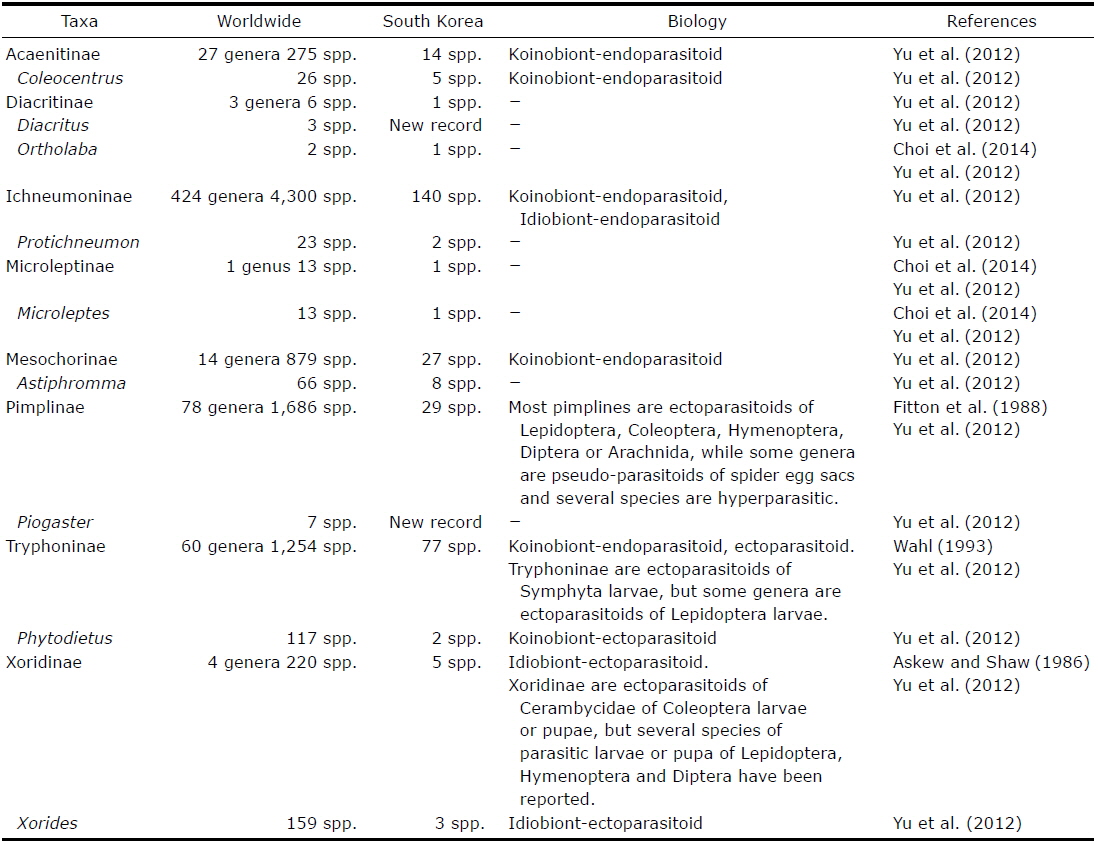
Known species number and biological information of taxa treated in this study
Digital images of habitus and diagnoses of ten newly recorded species from Korea are provided, along with available host information
Materials used in this study were collected with insect sweeping nets and Malaise traps, then deposited in the animal systematic laboratory of Yeungnam University (YNU, Gyeongsan, Korea). Specimens were examined with an AxioCam MRc5 camera attached to a stereomicroscope (Zeiss SteREO Discovery, V20; Carl Zeiss, Göttingen, Germany), processed using the AxioVision SE64 software (Carl Zeiss), and optimized with a Delta imaging system (i-solution; IMT i-Solution Inc., Vancouver, Canada). The morphological terminology mostly follows that of Townes (1969). Abbreviations were as follows: TD, type depository; DEI, Deutsches Entomologisches Institut, Schicklerstrasse 5, D-16225 Eberswalde, Germany; HU, Entomological Institute, Faculty of Agriculture, Hokkaido University, Sapporo, Japan; LS, Linnaean Society, Burlington House, Piccadilly, London, England, United Kingdom; MOMOI, Kobe University, Faculty of Agriculture, Entomological Laboratory, Kobe, Japan. (S. Momoi collection); NM, Naturhistorisches Museum, Stift Admont, A-8911 Admont, Austria (G. Strobl collection); NR, Naturhistoriska Riksmuseet, Sektionen för Entomologi, S-104 05 Stockholm, Sweden; TMA, Termeszettudomanyi Muzeum Allattara, Barossa-Utea 13, Budapest H-1088, Hungary; ZMHU, Zoologisches Museum (Museum für Naturkunde), Humboldt Universität, Invalidenstrasse 43, D-101115 Berlin, Germany; ZI, Zoologiska Institutionen, Helgonavägen 3, S-223 62 Lund, Sweden; ZIN, Zoological Institute, Academy of Sciences, St. Petersburg 199034, Russia; GW, Gangwon-do; GG, Gyeonggi-do; CB, Chungcheongbuk-do; CN, Chungcheongnam-do; GB, Gyeongsangbuk-do; JB, Jeollabuk-do; JN, Jeollanam-do; JJ, Jeju-do.
Order Hymenoptera
Family Ichneumonidae Latreille, 1802
Subfamily Acaenitinae Förster, 1869 (Korean name: Gon-bong-nab-jag-maeb-si-beol-a-gwa)
Material examined. Korea: 1♂, GW, Yanggu-gun, Gachilbong, 31 May 1992, Lee JW.
Diagnosis. Body length 14.5 mm. Antenna with 37 flagellomeres. Generally black. Antennal scape yellow ventrally Mesoscutum with strong notauli. Tegula yellow. Fore and mid legs yellow to brown; hind leg reddish brown to dark brown. Basal vein of fore wing opposite nervulus; areolet absent; nervellus of hind wing inclivous and discoidella absent.
Host. Unknown.
Distribution. Korea (new record), Belarus, Bulgaria, Germany, Hungary, Latvia, Poland, Romania, Russia (Kamchatka Oblast, Khabarovsk Kray, Primor’ye Kray, Sakhalin Oblast, Sankt Petersburg).
Subfamily Diacritinae Townes, 1965 (Korean name: Gin-bae-ma-di-maeb-si-beol-a-gwa)
Material examined. Korea: 2♂♂, GG, Pocheon-si, Soheur- eup, Jikdong-ri, Korea National Arboretum, ecology tower, 29 Jun-24 Jul 2013, Kim IG; 2♀♀, 2♂♂, GB, Cheongdo-gun, Unmun-myeon, Ssalbawi, Unmunsan, 1 Aug-21 Sep 2012, Lee JW.
Diagnosis. Body length 6-8 mm. Antenna with 23-26 flagellomeres, antennal flagellomeres with tyloids. Generally black. Head black in female and yellow in male. Head polished; clypeus small and separated from face by groove. Occipital carina reach hypostomal carina. Mesoscutum and mesopleurum glabrous, mesoscutum with strong notauli. Fore and mid legs yellow to brown. Hind leg dark brown. Propodeum with carinae and wrinkles. Fore wing with areolet. 1st and 2nd tergites with strongly numerous striate. 2nd to 7th tergites with yellow bands apically. Ovipositor longer than hind tibia.
Host. Unknown.
Distribution. Korea (new record), Austria, Belarus, Bulgaria, Czech, Finland, France, Georgia, Germany, Ireland, Japan, Lithuania, Netherlands, Poland, Romania, Russia (Primor’ye Kray, Pskov Oblast, Sakhalin Oblast), Slovakia, Sweden, United Kingdom.
Material examined. Korea: 1♀, 1♂, GW, Wonju-si, Panbu-myeon, Mt. Baekunsan, 28 Aug-5 Sep 2013, Lee JW.
Diagnosis. Body length 6 mm. Antenna with 21-24 flagel-lomeres. Generally black. Head with yellow spots at upper face in male and black in female. Occipital carina not reach hypostomal carina. 1st and 2nd tergites with dense punctures. 2nd to 7th tergites with yellow bands apically. Ovipositor longer than hind tibia.
Host. Unknown.
Distribution. Korea (new record), Japan, Russia (Primor’ye Kray).
Material examined. Korea: 1♂, GW, Hyangrobong, 13 Jun 1992, Lee JW; 1♀, CB, Danyang-gun, Danyang-eup, Cheondong-ri, Sobaeksan National Park, Cheondong Valley, 21 May-17 Jun 2007, Lee JW; 1♂, JN, Gurye-gun, Toji-myeon, Jirisan National Park, Piagol, 10 Mar-15 Jun 2010, Jeong JC.
Diagnosis. Body length 9-12 mm. Antenna with 28 flagellomeres. Generally black. Clypeus small and separated from face by transverse carina. Notauli deep and distinct. Mesosoma polished. Propodeum coarsely and rugosely punctate, with posterior transverse carina. Fore wing with triangular areolet. Legs yellow to reddish brown. Ovipositor longer than body length.
Host. Unknown.
Distribution. Korea (new record), China.
Remarks. This species is similar to
Subfamily Ichneumoninae Latreille, 1802 (Korean name: Maeb-si-beol-a-gwa)
Material examined. Korea: 2♂♂, Daejeon-si, Dong-gu, Daejeon University, 15-30 Jun 2006, Lee JW; 2♂♂, ditto, 11 Jun-28 Jul 2007, Lee JW.
Diagnosis. Body length 21 mm. Antenna with 50 flagellomeres. Generally black; head, antennal scape, mandible, lower temple and mesoscutellum yellow. Clypeus not separated from face, truncate. Pronotum and mesopleurum with yellow spots. Areola and petiolar areas separated by transverse carina. Legs with yellow and black bands. Fore wing with areolet. 2nd to 4th tergites reddish brown.
Host.
Distribution. Korea (new record), Afghanistan, Austria, Azerbaijan, Belarus, Belgium, Bosnia, Hercegovina, Bulgaria; Croatia, Czechoslovakia, Estonia, Finland, France, Georgia, Germany, Hungary, Iran, Ireland, Italy, Japan, Kazakhstan, Latvia, Lithuania, Moldova, Netherlands, Norway, Poland, Romania, Russia (Krasnoyarsk Kray, Novosibirsk Oblast, Tambov Oblast), Serbia and Montenegro, Slovakia, Spain, Sweden, Switzerland, Turkey, United Kingdom, Yugoslavia.
Subfamily Mesochorinae Förster, 1869 (Korean name: Eo-li-ja-lu-maeb-si-beol-a-gwa)
Material examined. Korea: 3♀♀, GG, Yangpyeong-gun, Youngmun-myeon, Yeonsu-ri, Mt. Yongmunsan, 1-26 May 2009, Lim JO; 1♀, GB, Yeungju-si, Punggi-eup, Jungnyeong, 21 May-3 Jun 2009, Lee JW; 1♀, JB, Jeongeup-si, Mt. Naejangsan, Baekhak-dong, 20 May 2005, Lee JW; 1♀, JB, Jeongeup-si, Naejang-dong, Geumseong, 20 Jun 2005, Lee JW.
Diagnosis. Body length 6.5 mm. Antenna with 38 flagellomeres, antennal scape longer than width. Generally black. Clypeus separated from face by transverse carina and yellow. Mandible and legs yellow to brown. Mesopleurum and mesoscutellum reddish brown. Fore wing with large rhombus areolet; nervulus of fore wing distad to basal vein. Discoidella of hind wing vestigial. Hind tarsal claw pectinate. Petiole with strong glymma and metasoma polished. Ovipositor sheath shorter than hind tibia.
Host.
Distribution. Korea (new record), Austria, Bulgaria, Czech Republic, Finland, France, Germany, Latvia, Lithuania, Netherlands, Poland, Romania, Sweden, United Kingdom.
Subfamily Microleptinae Townes, 1958 (Korean name: Mi-so-maeb-si-beol-a-gwa)
Material examined. Korea: 1♂, GW, Taebaek-si, Hyeol-dong, Mt. Taebaeksan, 13 Aug 1989, Lee JW; 1♂, JN, Gwangju-si, Buk-gu, Geumgok-dong, Mudeungsan National Park, Wonhyosa, 26 Jun-27 Jul 2013, Choi JK.
Diagnosis. Body length 4-4.5 mm. Antenna with 17-18 flagellomeres. Generally black; antenna and legs yellow to brown. Upper part of face convex; vertex wide and polished. Notauli weak. Propodeum with distinct carinae; areola and petiolar areas not separated. Fore wing without areolet. Petiole with numerous striate and glymma. Metasoma polished. 2nd tergite with rectangular thyridium.
Host. Unknown.
Distribution. Korea (new record), Belgium, Bulgaria, Finland, France, Germany, Ireland, Netherlands, Norway, Poland, Russia (Karachayevo-Cherkesskaya Oblast, Karel’skaya Respublika, Primor’ye Kray, Sakhalin Oblast, Sankt Petersburg), Sweden, United Kingdom.
Subfamily Pimplinae Wesmael, 1845 (Korean name: Nab-jag-maeb-si-beol-a-gwa)
Material examined. Korea: 2♀♀, Seoul, Nowon-gu, Sanggye 4-dong, Mt. Suraksan, 18 Jul-24 Aug 2007, Lim JO; 2♀♀, GG, Namyangju-si, Choan-myeon, Songchon-ri, Mt. Ungilsan, 27 May-10 Jun 2009, Lim JO; 2♀♀, GG, Namyangju-si, Joan-myeon, Songcheon-ri, Mt. Ungilsan, 37˚34′43.2″ N, 127˚18′37.5″ E, 26 Jun-16 Jul 2009, Lim JO; 1♀, ditto, 5-18 Sep 2009, Lim JO; 2♀♀, CB, Cheongwon- gun, Miwon-myeon, Miwon-ri, 9-16 Sep 2008, Han JH.
Diagnosis. Body length 4 mm. Antenna with 21 flagellomeres. Head rugosely punctate and black. Clypeus separated from face by groove. Vertex with yellow spots. Mesoscutellum and postscutellum yellow. Propodeum wrinkles, with lateral longitudinal carina. Fore wing without areolet; discoidella of hind wing absent. Legs yellow with black lines dorsally and ventrally. Metasoma pale yellow.
Host. Unknown.
Distribution. Korea (new record), Russia (Primor’ye).
Subfamily Tryphoninae Shuckard, 1840 (Korean name: Mung-tug-maeb-si-beol-a-gwa)
Material examined. Korea: 1♂, GG, Mt. Cheonggyesan, 4 May 1984, Lee JW; 1♀, GW, Wonju-si, Kyirae-myeon, Valley of Cheneun-sa, 5 Oct 1996, Lee SJ; 1♀, GW, Wonju- si, Heungeup-myeon, Maeji-ri, Yeonse Univ., 2 Sep-20 Oct 2009, Han HY; 1♀, GW, Wonju-si, Gwirae-myeon, Unnam-dong, 13 Oct 2001, Lim MH; 1♀, CB, Cheongwon- gun, Miwon-myeon, Miwon-ri, 23-30 Sep 2005, Han JH; 1♀, CB, Jecheon-si, Deokasan-myeon, Worak-ri, Deoksanmaepyoso, 14 Sep-1 Oct 2006, Lee JW; 1♀, CN, Seosan-si, Haemi-myeon, Daegok-ri, Hanseo Univ., 17-29 Sep 2009, Lee JW; 1♀, ditto, 29 Sep-10 Oct 2009, Lee JW; 1♀, Daegu-si, Nam-gu, Mt. Apsan, 29 Sep 2002, Lee JW; 1♀, GB, Ulleng-gun, Wada-ri, 18 Oct 2001, Kim CH; 1♀, JJ, 6 Aug 1981, Lee JW; 1♀, JJ, 5 Aug 1981, Park JS; 1♀, JJ, Jeju-si, Donggye-myeon, Jelmul, 11-18 Aug 2005, Sin CH.
Diagnosis. Body length 9-11 mm. Antenna with 41 flagellomeres. Generally yellow with black spots. Inner margin of eyes parallel. Mesoscutum with three black stripes and notauli strong. Carinae of propodeum incomplete, numerous striate. Hind tarsal claw pectinate. Basal vein of fore wing opposite nervulus. Areolet triangular. Discoidella of hind wing complete. Ovipositor longer than hind tibia.
Host. Unknown.
Distribution. Korea (new record), China, Taiwan, India, Japan, Myanmar, Russia (Sakhalin Oblast).
Subfamily Xoridinae Shuckard, 1840 (Korean name: E-jo-kko-li-nab-jag-maeb-si-beol-a-gwa)
Material examined. Korea: 1♂, Seoul, Dobong-gu, Mt. Dobongsan, 23 May 1990, Son SY; 1♂, Daejeon-si, Yongun- dong, 10 May 1994, Cho YS; 1♂, ditto, 11 May 1995, Lee IG.
Diagnosis. Body length 11-15 mm. Antenna with 24-28 flagellomeres, 9th-14th flagellomeres of antenna white. Generally black. Head with yellow spot at inner margin of eyes. Clypeus separated from face by strong carina and clypeus flat. Basal area of all tibiae yellow; mid and hind tarsi with partial white band. Nervulus of fore wing distad of basal vein. Areolet absent. Nervellus of hind wing 1/2 intercepted and discoidella complete.
Host.
Distribution. Korea (new record), Belarus, Bulgaria, China, Czecho, Finland, France, Germany, Hungary, Italy, Japan, Poland, Romania, Russia (Chita Oblast, Irkutsk Oblast, Primor’ye Kray, Sakhalin Oblast), Serbia and Montenegro, Sweden, Yugoslavia.


